Abstract
The use of disposable containers and packaging materials has increased due to the recent COVID-19 pandemic. Thus, the generation of plastic waste is also increasing, and research on recycling such waste is being actively conducted. In this study, an X-ray-shielding film for medical diagnosis was manufactured by mixing a radiation-shielding material and a plastic waste-based polymer material and its effectiveness was evaluated. The film, which is intended as a fabric for a shielding garment, consists of barium sulfate (BaSO4) shielding nanoparticles embedded in a matrix of polyethylene terephthalate (PET), a commonly available waste plastic material. A particle-dispersing technology, which can improve the ratio between the shielding and matrix materials while maintaining the tensile strength of the film, was studied. Therefore, to increase the content of the barium sulfate (BaSO4) nanoparticles used as the shielding material, this multi-carrier method—under which the particles are dispersed in units of time—was developed to improve the shielding performance. Compared with the effectiveness of lead (Pb) shielding film, the 3 mm barium sulfate film developed in this study satisfies the lead equivalent of 0.150 mmPb when stacked in two layers. Therefore, a shielding film was successfully manufactured by using plastic waste as a polymer resin and barium sulfate, an eco-friendly radiation-shielding material, instead of lead.
1. Introduction
Lead is the main material used in regular protective instruments and equipment for diagnostic X-ray shielding at medical institutions. However, because of its harmfulness and weight, lead is currently being replaced by eco-friendly and lightweight materials [1,2]. Barium sulfate (BaSO4), bismuth, and tungsten are the most frequently used eco-friendly shielding materials [3]. Numerous studies have been conducted on the shielding performance and manufacturing process technology of these materials, and products using these materials are currently being used in medical institutions [4,5].
Recent research on X-ray shielding for medical diagnosis is mainly aimed at the weight reduction and mass production of radiation-shielding fabrics, which are used in protective clothing [6]. The high weight of existing shielding suits made of lead limits the mobility of medical personnel, preventing them from performing many activities. Therefore, the lead in current shielding suits is being replaced with lightweight, eco-friendly materials such as tungsten. However, tungsten is more expensive than lead, which in turn increases the cost of shields manufactured with it. A solution to this problem, other than simply changing the shielding material, is to modify its density during the shield manufacturing process to improve shielding performance [7,8]. Additionally, for mass production, a dispersion technology for shielding materials that can support the reproducibility of films’ shielding performance is important [9,10,11].
When manufacturing equipment such as shielding sheets, the composition and density of the shielding material directly affect the shielding performance of the sheets [12]. Protective garments also require flexibility; therefore, polymer materials and shielding materials are usually mixed together to acquire the desired weight and flexibility of the protective clothing. Films, sheets, and plates are also manufactured in this way [13]. Thus, the role of the polymer in the production of protective garments is absolutely essential.
Radiation-shielding films are manufactured through extrusion molding, calendering, coating, and injection molding. Additionally, a laminate processing method is used, wherein several films are laminated together [14,15,16,17]. An important problem in this process is the low reproducibility of the shielding performance of the film, which is caused by pinholes produced in the manufacturing process [18]. Pinholes are created by the heterogeneous affinity between the polymeric and shielding materials. Solutions to remove the pinholes include improving the dispersion method for the particles of the shielding material and using a polymer material with a high affinity with the shielding material [19,20].
This study aims to improve the surface modification of the particles of the shielding material, increase even particle dispersion in the polymer matrix, remove pinholes in the shield, and maintain the reproducibility of the shielding performance of the film. Additionally, it aims to improve the economic feasibility of preparing X-ray-shielding films by using eco-friendly BaSO4 and plastic waste for the shielding and polymeric materials, respectively.
This study proposed and developed a multi-carrier process technology, which was applied to the particle dispersion technology of barium sulfate; this determined the shielding performance of the film. This technology allows particles to move in multiple directions from a high- to a low-pressure space. Using this technology, the polymer resin and shielding material particles were repeatedly mixed at a predetermined time unit to adjust the amount of the shielding material input per unit time and blend. In this case, the polymer could be adequately arranged around the nano-sized particles of the shielding material; this could play a role in reducing the pinholes inside the sheet. In addition, this study aimed to address the reduction that the shield tensile strength exhibits as a result of the thickness adjustment, and to propose a way for improving the bonding force between the polymers and the shielding material. The performance of the manufactured shielding film was compared with that of a standard lead film, and a way to maintain reproducibility through its evaluation is suggested. Considering that waste plastic is used as a polymer in the manufacturing process, a shield against low-dose radiation can be manufactured with a relatively high economic efficiency. The shield proposed in this study is manufactured with economical and eco-friendly barium sulfate, thus offering a solution to the problems of existing lead-based shields.
2. Materials and Methods
In diagnostic X-rays used in medical institutions, the intensity of the radiation emitted in a certain direction is provided by the Beer–Lambert law [21],
where I0 is the incident intensity, (cm−1) is the linear attenuation coefficient, (g/cm3) is the density of the shielding material, and (cm2/g) is the mass attenuation coefficient. Here, is the i-th weight ratio of the elements constituting the shield. Therefore, a shielding film with a thickness (cm) undergoes a change in strength owing to the interaction between the shielding material and the radiation during transmission . To increase the shielding rate, it is reasonable to increase the content or thickness of the shielding material [22].
Because manufacturing a thin film was of the utmost importance in this study, a shielding film with a thickness of only 3 mm was prepared. Although this can slightly lower the shielding performance, the resulting film can be used in a multi-layered structure to secure flexibility. Polyethylene terephthalate (PET) resin, a common industrial thermoplastic waste, was used in this study [23]. PET is generally used for plastic bottles, which are easily obtained as waste [24]. The proposed manufacturing process comprised three steps. First, PET bottles were collected, washed, and dried. Then, they were subjected to flake and chip processing and mixed with barium sulfate. Finally, the resulting mixture was extruded to form a film [25]. PET was prepared in the form of granules through the flaking process, as shown in Figure 1.
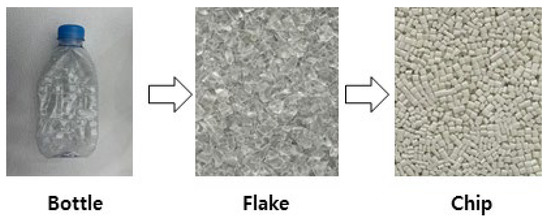
Figure 1.
Base material preparation using plastic waste material.
BaSO4 was selected as the shielding material for the manufacture of X-ray-shielding films. BaSO4 is an eco-friendly material that is harmless to the human body. It has a density of 4.49 g/cm3 [26]. Producing films with a thickness as low as 3 mm causes limitations in the shielding material content injection; thus, a method to increase the density inside the film was considered. To increase the interaction probability between the incident radiation and the shielding material, it is necessary to maximize the contact area between the shielding material and the polymer resin by increasing the interfacial miscibility. Therefore, a film production technology that reduced the particle size of the shielding material and simultaneously promoted the stabilization of the resin and barium sulfate interface to increase the dispersion power was needed.
In this study, BaSO4 nanoparticles acted as a physical barrier to prevent the self-aggregation of the PET resin. This was accomplished by developing a process technology that gradually injected the nanoparticles by controlling the amount of nanoparticles per time unit during the mixing process. The compounding process was continued for about 12 h, and BaSO4 nanoparticles were injected at a percentage of up to 5 wt% per h. The temperature was set to 260–280 °C. These compounding conditions turn PET into a gel state that is excellent for mixing. Injecting BaSO4 particles at 30–50 wt% improves the mixability compared to the existing process. As shown in Figure 2, the multi-carrier process technology can continuously increase the injection amount as one wall is formed, without the agglomeration of particles, which enables multi-faceted bonding between particles and polymers. The existing compounding process, which works by adding both the polymer and shielding materials simultaneously, results in lower polymer viscosity and surface activity. Maintaining constant viscosity of the polymer using inter-particle space pressure by constantly injecting the shielding material was effective [27]. In Figure 2a, it is difficult to move the particles due to the high viscosity of the polymer, but injecting BaSO4 nanoparticles step by step while maintaining the compounding process lowers the viscosity of the polymer. As shown in Figure 2b,c, a result that can inject more particles can be expected. Therefore, when the mixing process is performed, BaSO4 particles are dispersed due to the pressure difference according to the viscosity of the polymer, and particles are fixed by the polymer, thereby reducing interparticle aggregation of BaSO4. This process can increase the dispersibility of the BaSO4 particles and large amounts of shielding material. Figure 3 presents the internal structure of the shielding film using the multi-carrier phenomenon.

Figure 2.
Multi-carrier method using density difference between polymer resin and BaSO4 nanoparticles. (a) Particles of the shielding material are small compared to those of the initial polymer. The movement of nanoparticles increases toward (b,c), allowing more nanoparticles to fill than before.
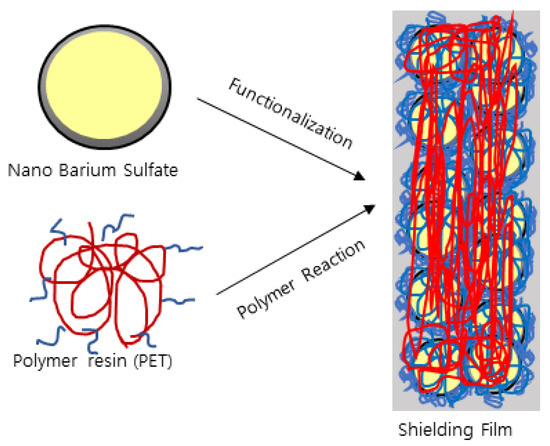
Figure 3.
Internal composition of the shielding film of BaSO4 nanoparticles and polymer resin.
In this experiment, barium sulfate was added up to 30–50 wt%, and as the content was high, the tendency of the strength to weaken due to the problem of the bonding force between the polymers was evaluated. The shielding film was manufactured with a thermoplastic resin film molding machine as shown in Figure 4. The content of the shielding material of the prepared shielding film was increased by 20 wt% compared to the conventional method; as a result, the content of the polymer material was different compared to the same area, so the tensile strengths were also evaluated. For tensile strength, KS M ISO 37, a test method for medical X-ray protective aprons (KS P 6023: 2018), was applied [28]. The size of the specimen was 100 × 100 × 3 mm, and the tensile speed was set to 200 ± 10 mm/min using AGX-V (Shimadzu Corp., 2010, Tokyo, Japan), a multi-purpose testing machine. The final manufactured shielding film is shown in Figure 5.
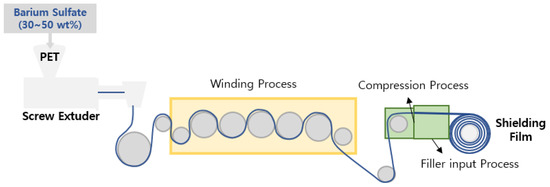
Figure 4.
Shielding film manufacturing process.
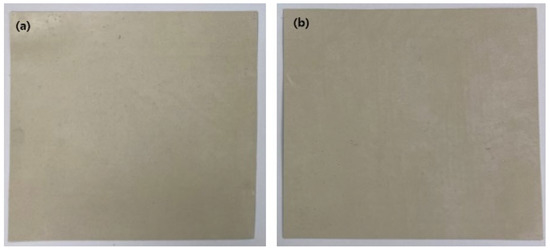
Figure 5.
300 × 300 × 3 mm shielding film with BaSO4 (a) 30 wt% and (b) 50 wt% content.
The particle dispersibility of the shielding material was observed with a field emissions scanning electron microscope (FESEM; S-4800, High-Tech Corp, Hitachi, Japan) after thin film sectioning with a microtome (Leica, RM2235, Wetzlar, Germany). The thickness of the manufactured shielding films was 3 mm, and the shielding performance of the films was evaluated based on the lead equivalent. The shielding performance was tested by designing a multilayer structure of 1, 2, and 3 sheets each. The energy used in this experiment was produced by an X-ray generator (Toshiba E7239, 150 kV–500 mA, 1999, Tokyo, Japan) used in a medical institution. After ten experiments, the average value was calculated and applied, and the calibrated DosiMax plus 1 (IBA Dosimetry Corp., 2019, Schwarzenbruck, Germany) was used as the dose detector. The energy used in the radiation diagnosis area of a medical institution was used in this experiment, and the irradiation dose was 40–120 kVp based on the tube voltage. In addition, as shown in Figure 6, backscattering was eliminated by leaving a 700 mm space behind the detector, and the distance from the X-ray generator to the detector was set to 1550 mm [29]. The shielding performance evaluation of the film was expressed as the shielding rate and was calculated according to the equation () × 100, where is the dose measured when there is a shielding film between the X-ray tube and the dosimeter and is the exposure dose measured when there is no shielding film between the X-ray tube and the dosimeter.
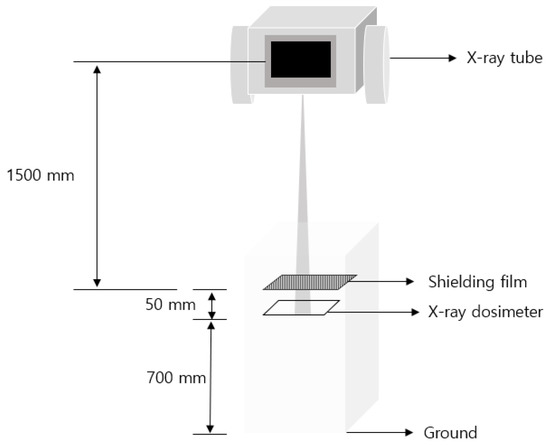
Figure 6.
Shielding performance evaluation test diagram.
3. Results
A thin shielding film that can be used in medical institutions was manufactured. As observed in Figure 7a, the existing injection process causes the aggregation of polymer materials. To remedy this, the shielding material must be uniformly disposed. In this study, several improvements were found by controlling the supply of the shielding material particles per hour as shown in Figure 7b. In addition, when the aggregation of the filler was prevented using the inner space of the shield, it could be dispersed more uniformly, as shown in Figure 7c. Therefore, this study developed and applied multi-carrier process technology using this principle.

Figure 7.
Particle movement of filling material to solve problems in conventional mixing methods. (a) A cross-sectional view of the film produced by the existing process technology, (b) the step of applying the multi-carrier process technology, (c) a cross-sectional view of the film produced by the multi-carrier process technology.
Figure 8a shows a cross-sectional SEM image of the shielding film produced by applying the conventional mixing method. As observed, it can be confirmed that fine pinholes are generated, which can be caused by aggregation between the shielding material particles. Figure 8b shows a cross-sectional SEM image of the film produced using the proposed multi-carrier method. Compared to Figure 8a, the number of pinholes in Figure 8b is reduced, the distribution of particles is even, and the aggregation of polymers is slightly reduced. Therefore, as observed, applying the multi-carrier process technology can predict the distribution state of the particles by controlling the polymer through the position of the particles of the shielding material.
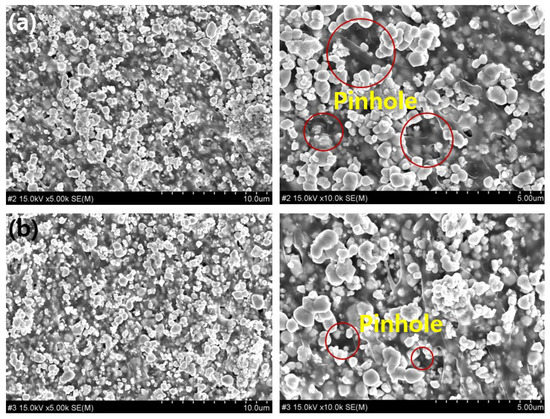
Figure 8.
Cross-sectional comparison of the shielding film produced by the existing process technology and the proposed multi-carrier technology. Cross-sectional views of the shielding sheet using the (a) existing process technology and (b) multi-carrier process technology.
The shielding performance of the prepared shielding film was evaluated. The shielding performance of standard lead and the manufactured shielding film are compared and evaluated. The shielding performance test results of the lead film are shown in Table 1. Based on these results, the shielding performance of the 3 mm shielding film was analyzed. The analysis revealed that for 0.3 mmPb, low-dose shielding was found to be 99.9%. Table 2 presents the lead-equivalent shielding performance by evaluating the performance when multiple 3 mm shielding films are stacked in a multi-layered structure. The shielding performance was further improved in the case of a multilayer structure, and using two 3 mm shielding films led to a 0.150 mmPb at 100 kVp. The dispersion of the BaSO4 nanoparticles was stable, and the change in the shielding performance was also linear. Table 3 summarizes the results of the comparison of the shielding performance of the films produced with the existing and proposed processes. These results were evaluated based on the difference between the process technology and the content of BaSO4 nanoparticles. While the thickness was the same, there was a difference in the amount of BaSO4 injected, which led to a 26.4% difference in shielding performance at 100 kVp. Therefore, the difference in the shielding performance of the film produced by the proposed technology and that by the existing process was confirmed. Table 4 presents the tensile strengths of 180 MPa for the produced shielding film, which had no significant difference from that of the existing shielding film. This indicates commercializing the manufactured film as a piece of shielding clothing is achievable.

Table 1.
Shielding performance evaluation of standard lead film (0.1, 0.2, and 0.3 mm).

Table 2.
Comparative evaluation of shielding performance by thickness when applying a multi-layer structure of X-ray-shielding film for medical diagnosis.

Table 3.
Comparative evaluation of content and shielding performance according to manufacturing process technology of X-ray-shielding film for medical diagnosis.

Table 4.
Characteristics of X-ray-shielding film for medical diagnosis.
4. Discussion
Medical personnel are exposed to varying degrees of radiation caused by the intensity and direction of radiation [30]. Direct rays act within a certain range and direction, which only affects the patient being tested [31]. The radiation exposure of workers in medical institutions is mainly affected by scattered rays. Shielding fabrics are manufactured into shields in the form of a thin film or a flexible sheet. In addition, thick plates can also be manufactured for garments requiring special strength. In the case of radiation-shielding clothing used in medical institutions, shielding performances of a minimum of 0.25 and 0.50 mmPb based on lead equivalents at 100 kVp are required. Therefore, it is manufactured in the form of sheets wherein a polymer and a shielding material are mixed. In particular, when a sheet with a performance of ≥0.50 mmPb is manufactured to shield a high dose of radiation, rubber is preferred as the mixed material to improve dispersion because of the high content of the shielding material [32].
This study was conducted with a foundationally deep interest in plastic wastes. The main components of plastic waste are polypropylene, ethylene-propylene copolymer, polystyrene, polyamide, polyethylene terephthalate, and polyvinyl chloride. Since this thermoplastic is bulky and inexpensive, it can be recycled [33]. However, in the case of thermosetting plastics, recycling is not possible. In recent years, there has been a mass production of plastic and its use has increased due to the COVID-19 pandemic. This eventually led to the problem of increased plastic waste [34].
Plastics can be recycled with eco-friendly and simple physical and mechanical methods [35]. Recycling is accomplished by collecting and washing plastic waste, converting it into flakes and granules through pulverization, and then melt processing it by drying and extrusion [36]. Therefore, if the recycled polymer resin and shielding material are mixed and processed as proposed in this study, the radiation-shielding film can be sufficiently manufactured and a shielding fabric with excellent economic efficiency can be produced.
The performance and characteristics of medical radiation shields are mostly affected by the composition of the shielding material used and the dispersion density generated when mixing with other materials [37]. Additionally, the shields should be lightweight and made of thin films, as they are mainly used for manufacturing protective clothing. Therefore, in this study a process technology was developed that increases the density in the polymer by processing the shielding material to nanosized particles. In previous studies, the content of the shielding material was approximately 5 wt% and 30 wt% for yarn and sheets, respectively [38]. This is because the properties of the particles were not considered. Currently, numerous studies are being conducted on process technologies involving the nanoparticle characteristics of tungsten particles in radiation shields [39].
The distribution of nanoparticles is determined at the processing stage, and the Brownian motion, which determines the distribution of the thermodynamic equilibrium state of these nanoparticles, tends to be inversely proportional to the viscosity [40]. Therefore, it is difficult to control the particle distribution of the shielding material because the polymer resin in the process step has a high viscosity and the processing time is very short. Rather than using thermodynamic calculations, it is necessary to study a method that can increase the binding force between the polymer and shielding material in the mixing procedure among the process technologies and apply a multi-carrier technology that mixes the nanoparticles with a time difference. Multi-carrier technology, which is used for blending the same polymer base with gradual pressure, increased the content of the shielding material by 20 wt% or more compared to the existing shielding material; the shielding performance was also improved.
The particle distribution of the shielding material inside the shield is essential; the uniform distribution of the shielding material and the amount of the shielding material input are separate issues [41]. Even when the same amount of shielding material is injected, errors may occur in shielding performance during mass production due to particle aggregation. In using shielding fabric for shielding clothing, it is important to control the amount of and uniform dispersion of the shielding material, which will increase the value of the product.
In this study, a 3 mm-thick shielding film for medical X-ray shielding was manufactured using barium sulfate, which is a cheaper alternative to shields made of plastic waste polymer and tungsten or lead, thus securing economic efficiency. In addition, because barium sulfate is an eco-friendly material, it is possible to solve environmental problems such as those caused when disposing of existing lead-based shields [42].
Furthermore, the 3 mm-thick shielding film can be used as a multi-layer structure to secure the flexibility of the shield, and when used as part of a multilayer structure, its shielding performance can be further adjusted as a function of the thickness. Additionally, it was suggested that using two films at 100 kVp for medical X-ray had the same effect that 0.150 mmPb did. Therefore, it is believed that the proposed technology in this study can support the mass production of eco-friendly and recyclable plastic waste shields.
5. Conclusions
In this study, economic efficiency was secured by manufacturing an X-ray-shielding film for medical diagnosis using waste-based PET. Nanoparticles of barium sulfate, an eco-friendly shielding material, were used as the shielding material, and multi-carrier process technology was applied to evenly disperse the particles in the polymer material. This process could increase the content of the shielding material by 20 wt% compared to that of the conventional mixing process. Laminating two shielding films together resulted in a shielding performance of 0.150 mmPb. These results show that the mass production of eco-friendly shielding films for manufacturing X-ray-shielding clothing for medical applications is achievable.
Funding
This work was supported by the Radiation Technology R&D program through the National Research Foundation of Korea, funded by the Ministry of Science and ICT (2020M2C8A1056950).
Institutional Review Board Statement
Not applicable.
Informed Consent Statement
Not applicable.
Data Availability Statement
Not applicable.
Conflicts of Interest
The authors declare no conflict of interest.
References
- Shoag, J.M.; Burns, K.M.; Kahlon, S.S.; Parsons, P.J.; Bijur, P.E.; Taragin, B.H.; Markowitz, M. Lead poisoning risk assessment of radiology workers using lead shields. Arch. Environ. Occup. Health 2019, 75, 60–64. [Google Scholar] [CrossRef] [PubMed]
- Özdemir, T.; Güngör, A.; Akbay, I.; Uzun, H.; Babucçuoglu, Y. Nano lead oxide and epdm composite for development of polymer based radiation shielding material: Gamma irradiation and attenuation tests. Radiat. Phys. Chem. 2018, 144, 248–255. [Google Scholar] [CrossRef]
- AbuAlRoos, N.J.; Amin, N.A.B.; Zainon, R. Conventional and new lead-free radiation shielding materials for radiation protection in nuclear medicine: A review. Radiat. Phys. Chem. 2019, 165, 108439. [Google Scholar] [CrossRef]
- Panetta, C.J.; Galbraith, E.M.; Yanavitski, M.; Koller, P.K.; Shah, B.; Iqbal, S.; Cigarroa, J.E.; Gordon, G.; Rao, S.V. Reduced radiation exposure in the cardiac catheterization laboratory with a novel vertical radiation shield. Catheter. Cardiovasc. Interv. 2019, 95, 7–12. [Google Scholar] [CrossRef]
- Lu, H.; Boyd, C.; Dawson, J. Lightweight Lead Aprons: The Emperor’s New Clothes in the Angiography Suite? Eur. J. Vasc. Endovasc. Surg. 2019, 57, 730–739. [Google Scholar] [CrossRef]
- Tekin, H.; Kavaz, E.; Papachristodoulou, A.; Kamislioglu, M.; Agar, O.; Guclu, E.A.; Kilicoglu, O.; Sayyed, M. Characterization of SiO2–PbO–CdO–Ga2O3 glasses for comprehensive nuclear shielding performance: Alpha, proton, gamma, neutron radiation. Ceram. Int. 2019, 45, 19206–19222. [Google Scholar] [CrossRef]
- Azman, N.Z.N.; Musa, N.F.L.; Ab Razak, N.N.A.N.; Ramli, R.M.; Mustafa, I.S.; Rahman, A.A.; Yahaya, N.Z. Effect of Bi2O3 particle sizes and addition of starch into Bi2O3–PVA composites for X-ray shielding. Appl. Phys. A 2016, 122, 818. [Google Scholar] [CrossRef]
- Aral, N.; Duch, M.A.; Ardanuy, M. Material characterization and Monte Carlo simulation of lead and non-lead X-Ray shielding materials. Radiat. Phys. Chem. 2020, 174, 108892. [Google Scholar] [CrossRef]
- Chanthima, N.; Kaewkhao, J. Investigation on radiation shielding parameters of bismuth borosilicate glass from 1keV to 100GeV. Ann. Nucl. Energy 2013, 55, 23–28. [Google Scholar] [CrossRef]
- Khan, M.U.; Ahmad, S.; Naqvi, A.A.; Al-Gahtani, H.J. Shielding performance of heavy-weight ultra-high-performance concrete against nuclear radiation. Prog. Nucl. Energy 2020, 130, 103550. [Google Scholar] [CrossRef]
- Deng, Y.; Liu, J. Liquid Metal Based Stretchable Radiation-Shielding Film. J. Med. Devices 2015, 9, 014502. [Google Scholar] [CrossRef]
- Li, R.; Gu, Y.; Wang, Y.; Yang, Z.; Li, M.; Zhang, Z. Effect of particle size on gamma radiation shielding property of gadolinium oxide dispersed epoxy resin matrix composite. Mater. Res. Express 2017, 4, 035035. [Google Scholar] [CrossRef]
- Eskalen, H.; Kavun, Y.; Kerli, S.; Eken, S. An investigation of radiation shielding properties of boron doped ZnO thin films. Opt. Mater. 2020, 105, 109871. [Google Scholar] [CrossRef]
- Gilys, L.; Griškonis, E.; Griškevičius, P.; Adlienė, D. Lead Free Multilayered Polymer Composites for Radiation Shielding. Polymers 2022, 14, 1696. [Google Scholar] [CrossRef]
- Li, Q.; Zhong, R.; Xiao, X.; Liao, J.; Liao, X.; Shi, B. Lightweight and Flexible Bi@Bi-La Natural Leather Composites with Superb X-ray Radiation Shielding Performance and Low Secondary Radiation. ACS Appl. Mater. Interfaces 2020, 12, 54117–54126. [Google Scholar] [CrossRef]
- Sazali, M.A.; Rashid, N.K.A.; Hamzah, K. A review on multilayer radiation shielding. IOP Conf. Ser. Mater. Sci. Eng. 2019, 555, 012008. [Google Scholar] [CrossRef]
- Kang, J.H.; Oh, S.H.; Oh, J.-I.; Kim, S.-H.; Choi, Y.-S.; Hwang, E.-H. Protection evaluation of non-lead radiation-shielding fabric: Preliminary exposure-dose study. Oral Radiol. 2018, 35, 224–229. [Google Scholar] [CrossRef]
- Li, Q.; Wei, Q.; Zheng, W.; Zheng, Y.; Okosi, N.; Wang, Z.; Su, M. Enhanced Radiation Shielding with Conformal Light-Weight Nanoparticle–Polymer Composite. ACS Appl. Mater. Interfaces 2018, 10, 35510–35515. [Google Scholar] [CrossRef]
- Singh, A.K.; Singh, R.K.; Sharma, B.; Tyagi, A.K. Characterization and biocompatibility studies of lead free X-ray shielding polymer composite for healthcare application. Radiat. Phys. Chem. 2017, 138, 9–15. [Google Scholar] [CrossRef]
- Baek, Y.M.; Shin, P.S.; Kim, J.H.; Park, H.S.; Kwon, D.J.; Park, J.M. Comparison of Mechanical and Interfacial Properties of Carbon Fiber Reinforced Recycled PET Composites with Thermoforming Temperature and Time. Compos. Res. 2017, 30, 175–180. [Google Scholar] [CrossRef]
- Şakar, E.; Özpolat, F.; Alım, B.; Sayyed, M.; Kurudirek, M. Phy-X/PSD: Development of a user friendly online software for calculation of parameters relevant to radiation shielding and dosimetry. Radiat. Phys. Chem. 2019, 166, 108496. [Google Scholar] [CrossRef]
- Cheewasukhanont, W.; Limkitjaroenporn, P.; Kothan, S.; Kedkaew, C.; Kaewkhao, J. The effect of particle size on radiation shielding properties for bismuth borosilicate glass. Radiat. Phys. Chem. 2020, 172, 108791. [Google Scholar] [CrossRef]
- EFSA Panel on Food Contact Materials, Enzymes and Processing Aids (CEP); Lambré, C.; Baviera, J.M.B.; Bolognesi, C.; Chesson, A.; Cocconcelli, P.S.; Crebelli, R.; Gott, D.M.; Grob, K.; Mengelers, M.; et al. Safety assessment of the process Plastrec, based on Polymetrix pellet technology, used to recycle post‐consumer PET into food contact materials. EFSA J. 2021, 19, e06560. [Google Scholar] [CrossRef] [PubMed]
- Jabłońska, B.; Kiełbasa, P.; Korenko, M.; Dróżdż, T. Physical and Chemical Properties of Waste from PET Bottles Washing as A Component of Solid Fuels. Energies 2019, 12, 2197. [Google Scholar] [CrossRef] [Green Version]
- Botelho, M.; Künzel, R.; Okuno, E.; Levenhagen, R.; Basegio, T.; Bergmann, C. X-ray transmission through nanostructured and microstructured CuO materials. Appl. Radiat. Isot. 2010, 69, 527–530. [Google Scholar] [CrossRef] [Green Version]
- Lee, J.-W.; Kweon, D.C. Evaluation of radiation dose reduction by barium composite shielding in an angiography system. Radiat. Eff. Defects Solids 2020, 176, 368–381. [Google Scholar] [CrossRef]
- Salehiyan, R.; Ray, S.S. Tuning the Conductivity of Nanocomposites through Nanoparticle Migration and Interface Crossing in Immiscible Polymer Blends: A Review on Fundamental Understanding. Macromol. Mater. Eng. 2018, 304, 1800431. [Google Scholar] [CrossRef]
- Choi, Y.I.; Ye, S.Y.; Kim, J.H. Evaluation of the Apron Effectiveness during Handling Radiopharmaceuticals in PET/CT Work Environment. J. Radiol. Sci. Technol. 2015, 38, 237–244. [Google Scholar] [CrossRef]
- Harwood, J.R.; Nelli, F.E. A model-based algorithm to correct for the loss of backscatter in superficial X-ray radiation therapy. Phys. Med. 2019, 65, 157–166. [Google Scholar] [CrossRef]
- Mahesh, M. Radiation Dose Management for Fluoroscopically Guided Interventional Medical Procedures. Med. Phys. 2012, 39, 5789–5790. [Google Scholar] [CrossRef]
- Yun, J.; Hou, J.; Jang, W.; Kim, S.; Byun, H. Electrospun Tungsten‐Polyurethane Composite Nanofiber Mats for Medical Radiation‐Shielding Applications. ChemNanoMat 2021, 8, e202100387. [Google Scholar] [CrossRef]
- Sharma, A.; Sayyed, M.; Agar, O.; Kaçal, M.; Polat, H.; Akman, F. Photon-shielding performance of bismuth oxychloride-filled polyester concretes. Mater. Chem. Phys. 2019, 241, 122330. [Google Scholar] [CrossRef]
- More, C.V.; Alsayed, Z.; Badawi, M.S.; Thabet, A.A.; Pawar, P.P. Polymeric composite materials for radiation shielding: A review. Environ. Chem. Lett. 2021, 19, 2057–2090. [Google Scholar] [CrossRef]
- Silva, A.L.P.; Prata, J.C.; Walker, T.R.; Campos, D.; Duarte, A.C.; Soares, A.M.; Barcelò, D.; Rocha-Santos, T. Rethinking and optimising plastic waste management under COVID-19 pandemic: Policy solutions based on redesign and reduction of single-use plastics and personal protective equipment. Sci. Total Environ. 2020, 742, 140565. [Google Scholar] [CrossRef]
- Cabrera, F.C. Eco‐friendly polymer composites: A review of suitable methods for waste management. Polym. Compos. 2021, 42, 2653–2677. [Google Scholar] [CrossRef]
- Sadat-Shojai, M.; Bakhshandeh, G.-R. Recycling of PVC wastes. Polym. Degrad. Stab. 2011, 96, 404–415. [Google Scholar] [CrossRef]
- Alshahri, S.; Alsuhybani, M.; Alosime, E.; Almurayshid, M.; Alrwais, A.; Alotaibi, S. LDPE/Bismuth Oxide Nanocomposite: Preparation, Characterization and Application in X-ray Shielding. Polymers 2021, 13, 3081. [Google Scholar] [CrossRef]
- Lai, M.-F.; Huang, C.-H.; Lou, C.-W.; Wei, C.-Y.; Lin, J.-H. Multi-walled Carbon Nanotubes/Polypropylene-based Coating Layer on the Composite Metal Filaments: Characteristic Evaluations and Radiation-shielded Fabric. Fibers Polym. 2022, 23, 768–774. [Google Scholar] [CrossRef]
- Aral, N.; Duch, M.A.; Nergis, F.B.; Candan, C. The effect of tungsten particle sizes on X-ray attenuation properties. Radiat. Phys. Chem. 2021, 187, 109586. [Google Scholar] [CrossRef]
- Sabir, Z.; Ayub, A.; Guirao, J.L.G.; Bhatti, S.; Shah, S.Z.H. The Effects of Activation Energy and Thermophoretic Diffusion of Nanoparticles on Steady Micropolar Fluid along with Brownian Motion. Adv. Mater. Sci. Eng. 2020, 2020, 1–12. [Google Scholar] [CrossRef]
- Malekzadeh, R.; Mehnati, P.; Sooteh, M.Y.; Mesbahi, A. Influence of the size of nano- and microparticles and photon energy on mass attenuation coefficients of bismuth–silicon shields in diagnostic radiology. Radiol. Phys. Technol. 2019, 12, 325–334. [Google Scholar] [CrossRef]
- Lopresti, M.; Palin, L.; Alberto, G.; Cantamessa, S.; Milanesio, M. Epoxy resins composites for X-ray shielding materials additivated by coated barium sulfate with improved dispersibility. Mater. Today Commun. 2020, 26, 101888. [Google Scholar] [CrossRef]
Publisher’s Note: MDPI stays neutral with regard to jurisdictional claims in published maps and institutional affiliations. |
© 2022 by the author. Licensee MDPI, Basel, Switzerland. This article is an open access article distributed under the terms and conditions of the Creative Commons Attribution (CC BY) license (https://creativecommons.org/licenses/by/4.0/).